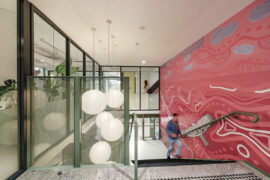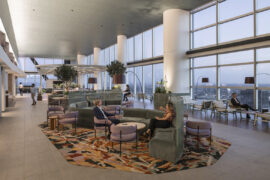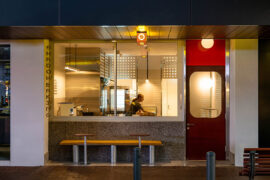UniSA Professor David Ness played a key role in a UN report on CO2 emissions relating to buildings, construction and urban growth which underpins the Buildings Breakthrough official launch at COP28 in Dubai.

David Ness
December 11th, 2023
Indesignlive: Can you tell us about your background, current role/s, and your involvement in the recent COP28?
Growing up amid post-war austerity, I have always had a passion for social justice and abhor extravagance. Following an early interest in art, I embarked upon a career in architecture that led me to focus upon strategic asset and infrastructure planning. A chance meeting with a UN Chief for Sustainable Development found me on a UN Mission to assess clean development across Asian cities, then leading an international training course on resource-efficient urban infrastructure.
A move to university research enabled me to pursue my passion for equitable resource consumption, winning the Arup 2017 Global Research Challenge to adapt the circular economy to the built environment. I realised that reducing resource consumption was largely missing from attempts to mitigate climate change, with energy efficiency and renewables attracting most attention. Thankfully, the High-Level Champion for the Built Environment agreed with my critiques and addressed this deficiency within the ‘Buildings Breakthrough’ launched at COP28.
“The first step is to question the need to build at all.”
How important is the built environment in tackling the climate crisis?
The building and construction sector, responsible for 37 per cent of global emissions, 50 per cent of resource extraction, and 40 per cent of waste, plays a critical role in tackling the interlinked crises of climate change, nature loss and inequality. Until recently, operational emissions dominated efforts to reach Net-Zero CO2 by 2050, while consumption carbon (including that ‘embodied’ in production of materials and construction) has largely been overlooked. Without intervention, embodied carbon will constitute an astonishing 85 per cent of all emissions by 2050.
Incredibly, the industry expects the current ‘building binge’ to continue until 2060, with the equivalent of Paris being added in new building every five days, while still believing it can be ‘green’ due to biomaterials, low-carbon concrete and new technologies. This misconception is fostered by green building rating systems that award highest ‘platinum’ or ‘6-Star’ credentials to skyscrapers with green features. In a report to COP28, the US Green Building Council claims that “absolute U.S. commercial building emissions have decreased to 1990 levels despite a 55 per cent increase in U.S. commercial floor area over the same period.” Changing such mindsets and claims is much like trying to alter the course of the Titanic!
Related: Q&A on AI with Woods Bagot’s Jet Geaghan

What agency can architects, designers and all those in the design industry exercise in relation to climate?
The greatest amount of carbon and cost is associated with early decisions, including whether to build new or retrofit. While designers often work at the behest of their clients, they can challenge briefs and guide clients towards less resource-intensive solutions, which not only cut client costs but also greatly reduce emissions. Although building less may be seen to impact negatively on fees, there are opportunities for a closer ongoing relationship with clients and assisting them to meet climate reporting and other obligations.
The first step is to question the need to build at all, while considering other options to meet client and community needs such as retrofitting, and increased utilisation and sharing of existing facilities. Meeting the climate emergency demands creative and transformative thinking and approaches, and this is where the design industry can play a major role. For example, Lacaton & Vassal won the Pritzker Prize for their modest approach to design, such as recommending a minimalist intervention for a city square.
What is the ‘Buildings Breakthrough’ initiative at COP28?
The launch of the initiative at COP28 and drawing together so many key stakeholders was a necessary and important step forward – the building and construction sector is lagging badly in meeting climate targets and much remains to be done. While the target of ‘near zero emissions and resilient buildings are the new normal by 2030’ (via doubling energy efficiency and tripling renewables) was laudable, any gains may continue to be offset by global growth in floor area – arguably the ‘elephant in the COP room.’
While the launch has set the scene and created momentum, it will be critical to address this major challenge at the subsequent Global Forum on Buildings and Climate to be held in Paris 7-8th March 2024. In this regard, the Breakthrough Report recommended that “sufficiency measures must complement the role played by efficiency, behaviour and renewables in the mitigation of emissions… The impact of sufficiency efforts needs to be more widely understood, with implementation efforts led by developed countries which have a larger floor area per capita to repurpose, and less pressure from population growth and urbanisation”.

You’ve written about the concept of ’sufficiency’ – can you tell us what you mean by this, and how it might affect the built environment?
Dr Yamina Saheb, my Paris-based colleague and IPCC lead author, was responsible for introducing the sufficiency concept within the IPCC Mitigation Report 2022: policies and measures that avoid consumption of energy, materials, land, water and other natural resources while ensuring wellbeing for all within planetary boundaries. The IPCC has emphasised that sufficiency policies, coupled with those for energy efficiency and renewables, are essential to limit warming to 1.5oC.
Most of all, to have a major impact, sufficiency requires questioning upfront the demand for new construction, especially in developed countries. For example, is a new office tower really required when employees may be working mainly from home and new digital means of transactions are available? Moreover, the advent of carbon budgets may lead to prioritisation of, say, social housing over profit-orientated commercial structures. Finding ways to make better use of existing space by sharing and increased utilisation, along with building less, will reduce generating new carbon emissions.
We’re not doing enough right now – what are your priorities for the future?
At a global level, I aim to ensure that ‘sufficiency and growth of floor area’ is high on the agenda for the Buildings and Climate Global Forum, with the flyer asserting that “the global buildings surface should double by 2060”. To challenge such thinking, via a comparative study involving an Australia-China team, I am examining to what extent reducing and rebalancing growth in floor area in an equitable manner may mitigate emissions and ecological breakdown, and what policies and mechanisms are required.
Closer to home, I am promoting discussion of sufficiency policies that constrain the amount of new construction to meet genuine needs, while prioritising adaptive reuse. My research has shown that current high-growth policies for the City of Adelaide and Greater Adelaide conflict with Climate Change obligations.
COP28
cop28.com

We think you might also like this story on Lacaton & Vassal’s visit to Sydney in 2023.
INDESIGN is on instagram
Follow @indesignlive
A searchable and comprehensive guide for specifying leading products and their suppliers
Keep up to date with the latest and greatest from our industry BFF's!

At the Munarra Centre for Regional Excellence on Yorta Yorta Country in Victoria, ARM Architecture and Milliken use PrintWorks™ technology to translate First Nations narratives into a layered, community-led floorscape.

For those who appreciate form as much as function, Gaggenau’s latest induction innovation delivers sculpted precision and effortless flexibility, disappearing seamlessly into the surface when not in use.

For a closer look behind the creative process, watch this video interview with Sebastian Nash, where he explores the making of King Living’s textile range – from fibre choices to design intent.

In an industry where design intent is often diluted by value management and procurement pressures, Klaro Industrial Design positions manufacturing as a creative ally – allowing commercial interior designers to deliver unique pieces aligned to the project’s original vision.

From radical material reuse to office-to-school transformations, these five projects show how circular thinking is reshaping architecture, interiors and community spaces.

Designed by Woods Bagot, the new fit-out of a major resources company transforms 40,000-square-metres across 19 levels into interconnected villages that celebrate Western Australia’s diverse terrain.

In an industry where design intent is often diluted by value management and procurement pressures, Klaro Industrial Design positions manufacturing as a creative ally – allowing commercial interior designers to deliver unique pieces aligned to the project’s original vision.
The internet never sleeps! Here's the stuff you might have missed

Working within a narrow, linear tenancy, Sans Arc has reconfigured the traditional circulation pathway, giving customers a front row seat to the theatre of Shadow Baking.

True sustainability doesn’t have to be complicated. As Wilkhahn demonstrate with their newest commercial furniture range.